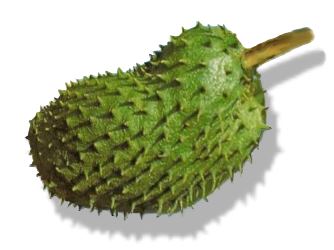Guyabano Nutritional Value*
Per 100g of edible portion |
Calories |
65 |
Protein |
1.0 g |
Fat |
0.95g |
Carbohydrates |
16.5g |
Fiber |
3.2 g |
Ash |
58g |
Calcium |
10.3 mg |
Phosphorus |
26.9 mg |
| Potassium |
270 mg |
Iron |
0.64 mg |
Vitamin A |
2 IU |
| Vitamin C |
28.5 mg |
Thiamine |
0.10 mg |
Riboflavin |
0.06 mg |
Niacin |
1.3 mg |
Tryptophan |
11 mg |
Methionine |
8 mg |
| Lysine |
60 mg |
 Guyabano/Soursop Fruit Nutrition Guyabano/Soursop Fruit Nutrition
Guyabano belongs to the family of Annonaceae, (A. muricata
L.). The flesh of the fruit consist of a white edible pulp that
is high in carbohydrates and considerable amounts of Vitamin C,
Vitamin B1, Vitamin B2, Potassium and dietary fiber. Guyabano is low
in cholesterol, saturated fat and sodium. No only is guyabano a good
health food, it also taste delicious. The tree and fruit is known in
various names: Guyabano in Filipino, Soursop in English, Graviola in
Brazil, and Guanabana in Spanish.
About the Guyabano
The heart shaped / oblong guyabano fruit has a dark green, leathery
and spike-like skin that measures from 8 to 12 inches long and can
weigh up to 2.5 kilos. The creamy and delectable flesh contains from
60 to 100 black-brown seeds that are indigestible and non-edible.
The guyabano tree is relatively small. It usually grows from 8 to
less than 20 feet high and is sensitive to very cold temperatures.
The guyabano tree requires a lot of water, warmth and humidity and
is usually grown in the tropics. It is cultivated commercially in
Central & South America, West Africa, Asia and South Florida in
limited numbers.
Products made from Guyabano fruit:
Aside from being eaten raw, the guyabano fruit is processed into
candies, tarts, shakes, ice-cream, sherbets and other beverages.
Medicinal Uses of Guyabano
Guyabano has been used as folkloric herbal medicine in many regions
thought the world. It is considered to be antispasmodic, sudorific
and emetic. A decoction (boiling in water) of guyabano leaves is
used to kill bedbugs and head lice.
To reduce fever, a decoction of leaves can be taken internally or
the leaves added to bathing water also has the same effect. The
crushed fresh leaves are also applied on skin eruptions for faster
healing. A poultice of young guyabano leaves is applied on the skin
to alleviate rheumatism and other skin infections like eczema.
Applied during the healing of wounds, this can result in less or no
skin scars. The decoction can also be used as a wet compress on
swollen feet and other inflammations.
The juice of the fruit is taken orally as a herbal remedy for
urethritis, haematuria and liver ailments.
Studies are underway by leading medical institutes, universities and
pharmaceutical companies of the healing properties of guyabano
against cancers. Initial findings show that certain compounds and
chemicals extracted from guyabano leaves, seeds, fruit and bark
appear to kill cancer cells while leaving normal cells remain unaffected.
Other uses of Guyabano
Pulverizing the guyabano seeds and mixing it with soap & water is
used as effective spray against caterpillars, armyworms and
leafhoppers on plants.
The guyabano leaves are believed to have a tranquilizing and
sedative properties. In the Netherlands Antilles, the leaves are
placed inside pillows or placed on top of the mattress to induce a
good night's sleep.
|

 Guyabano/Soursop Fruit Nutrition
Guyabano/Soursop Fruit Nutrition